Hello, I'm very new here. I am a master electrician by trade (solar is not my forte), and I recently purchased a customized off-grid solar "kit" online and I wanted to pick everyones brain on an issue I'm having with the 6000w Aims inverter. I will start with the system. I am running a 48V system, with 8 - 100 Ah Battle Born Lithium batteries, wired in series and parrallel. I have verified with the BB people that I have the batteries connected correctly, however that is not the issue. (see pictures for the setup) I also have a Victron - MPPT TR 150V 70A 12/24/36/48 solar charge controller, and, as mentioned already, an Aims power 6000W Pure Sine inverter charger. As far as the panels, I have (12) - 305W panels (S-energy 3m305M-10T) wired in strings of (4) ea back to a factory installed combiner box.
I am using the Victron BMV-712 battery monitor to monitor my battery voltages and battery life.
The problem: Long short of it is, I installed a manual transfer switch on the panel that feeds my inside electrical panel (lights and plugs). The batteries charge flawlessly to 100% with no problem. Like I said I'm new to this, but I set up the Victron solar charge controller and battery monitor as per the Victron online setup instructions for battle born batteries, so I am confident that this part of the system is setup correctly. I have noticed that when the battery bank is fully charged, the battery voltage is like 56.6V and as the batteries drain, that voltage begins to decrease.
My first two nights in a row, I'll go out a check the battery life with the Victron battery monitor app, after the sun goes down (around 9pm) Keep in mind, I am only running a few lights and plugs (about 1200W max) on the inverter. The battery monitor will show like 83% of battery capacity left. I may be reading the Victron monitor app wrong but it will show, at the current load, there is XX amount of battery life left. Which in my case showed about 1 day and 6 hours left, however when the battery bank voltage drops below 48V, my inverter shuts off as well as the power in my home. It seems as though I'm not maximizing the amount of time I can go without the batteries being charged. Not sure what to check or correct, or, is this about right, 4-5 hours of use @ 1200W to drain the 83% remaing battery life? This happened the first few days and nights we used the system.
My question is do they make a better inverter, or inverter/charge controll system that may prolong how long I can use the inverter power?
Questions? comments? any help will be much appriciated. I will include pictures of my setup.
I am using the Victron BMV-712 battery monitor to monitor my battery voltages and battery life.
The problem: Long short of it is, I installed a manual transfer switch on the panel that feeds my inside electrical panel (lights and plugs). The batteries charge flawlessly to 100% with no problem. Like I said I'm new to this, but I set up the Victron solar charge controller and battery monitor as per the Victron online setup instructions for battle born batteries, so I am confident that this part of the system is setup correctly. I have noticed that when the battery bank is fully charged, the battery voltage is like 56.6V and as the batteries drain, that voltage begins to decrease.
My first two nights in a row, I'll go out a check the battery life with the Victron battery monitor app, after the sun goes down (around 9pm) Keep in mind, I am only running a few lights and plugs (about 1200W max) on the inverter. The battery monitor will show like 83% of battery capacity left. I may be reading the Victron monitor app wrong but it will show, at the current load, there is XX amount of battery life left. Which in my case showed about 1 day and 6 hours left, however when the battery bank voltage drops below 48V, my inverter shuts off as well as the power in my home. It seems as though I'm not maximizing the amount of time I can go without the batteries being charged. Not sure what to check or correct, or, is this about right, 4-5 hours of use @ 1200W to drain the 83% remaing battery life? This happened the first few days and nights we used the system.
My question is do they make a better inverter, or inverter/charge controll system that may prolong how long I can use the inverter power?
Questions? comments? any help will be much appriciated. I will include pictures of my setup.




